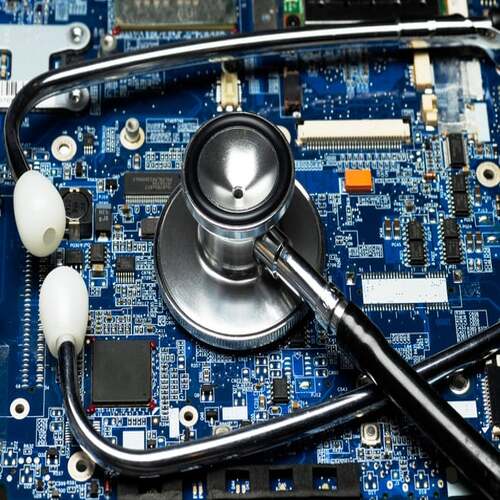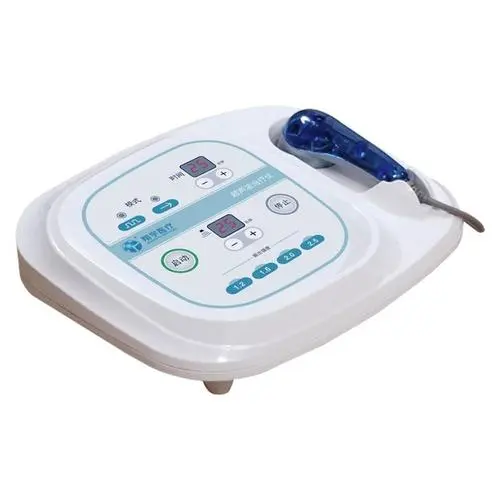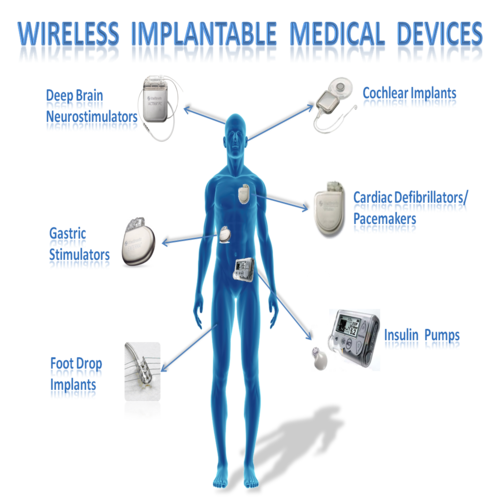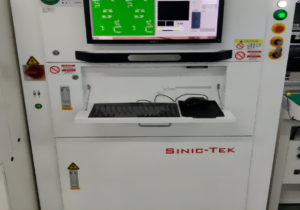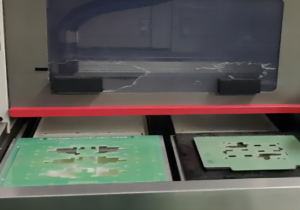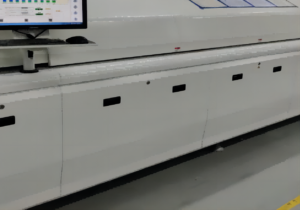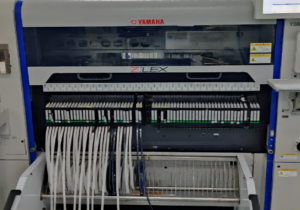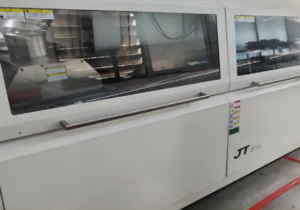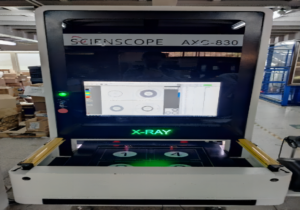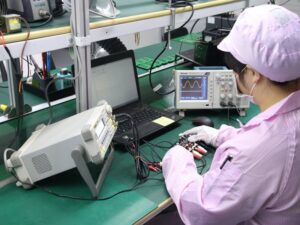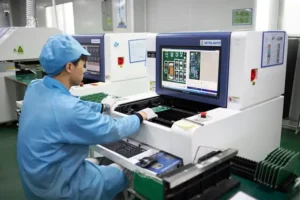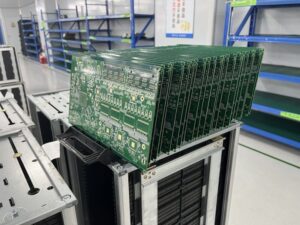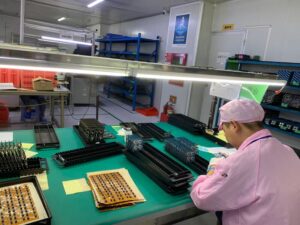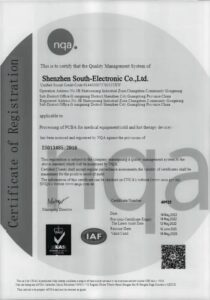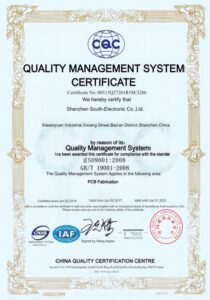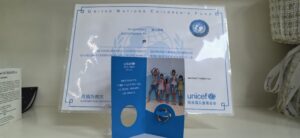The Complete Guide For Medical PCB
Content
Chapter 1
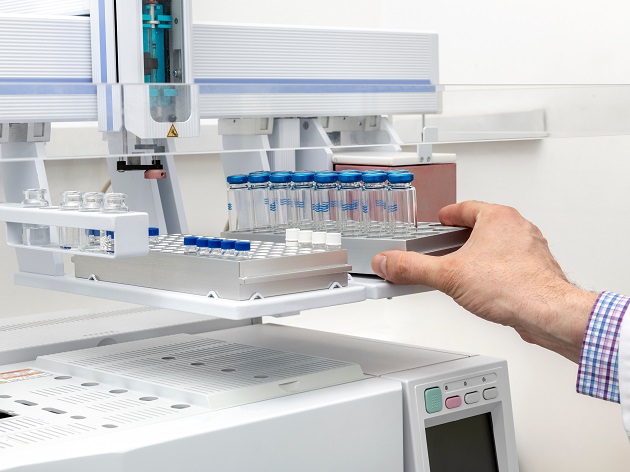
Introduction to Medical PCB
Medical PCB is specialized PCB designed for medical applications, where reliability and precision are critical.
It play a crucial role in various medical devices such as heart monitors, glucose meters, and imaging equipment like CT scanners.
The production of the PCB requires adherence to strict standards to ensure safety and functionality in medical environments. The design process typically involves meticulous planning and testing to ensure the boards meet all necessary medical and technical requirements.
Chapter 2
Types of Medical PCB
Medical PCB varies in type based on their application within the medical field. The most common types are rigid, flexible, and rigid-flex PCB. Each type offers distinct advantages that make it suitable for different medical applications.
Diagnostic Devices PCB:
- Imaging Systems: Used in MRI, CT scan, ultrasound, and X-ray machines.
- Monitoring Systems: For devices that monitor heart rate, blood pressure, glucose levels, etc.
Treatment Equipment PCB:
- Therapeutic Devices: Such as electrical stimulation devices, dialysis machines, and medical lasers.
- Surgical Devices: Used in robotic surgical instruments, endoscopic units, and other automated surgical systems.
Patient Monitoring PCB:
- Wearable Technology: Includes PCB for wearable health monitoring devices like fitness trackers and advanced prosthetics.
- Hospital Care Equipment: For patient monitoring systems, infusion pumps, and medical ventilators.
Laboratory Medical Devices:
- Analytical Instruments: Such as blood analyzers, DNA analyzers, and other laboratory diagnostic equipment.
- Research Equipment: PCB used in devices for medical research, including spectrometers and chromatographs.
Implantable Medical Device PCB:
- Pacemakers: Small devices that help control abnormal heart rhythms.
- Implantable Cardioverter Defibrillators (ICD): Devices that detect and stop arrhythmias.
Portable Medical Devices:
- Handheld Instruments: Such as portable ultrasound machines and blood analysis devices.
- Emergency Medical Devices: Like portable defibrillators and handheld diagnostic instruments.
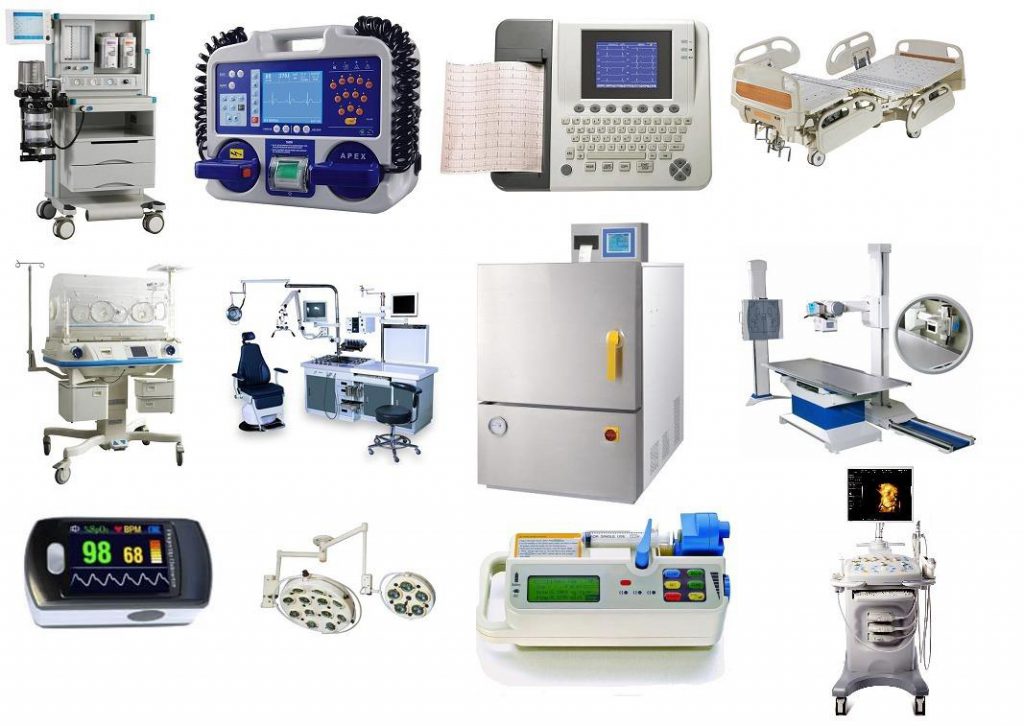
Chapter 3
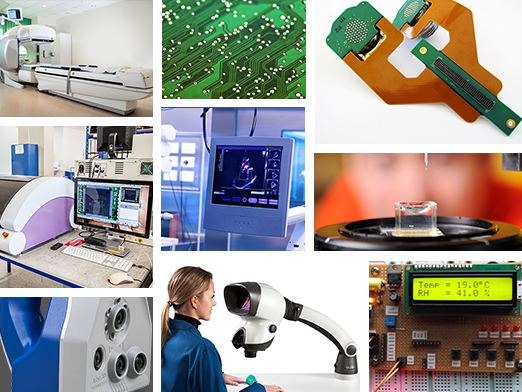
Components of a Medical PCB
Medical PCB is complex assemblies that contain a variety of electronic components to achieve the specific functions required of medical devices. These components must be reliable, precise, and able to operate in the sensitive and often harsh environments typical of medical settings. South-Electronic is a leader in the medical PCB industry, ensuring that each PCB is assembled to the highest quality and performance standards. Below, we detail the common components found on medical PCBs and their critical roles in medical applications.
Microcontrollers and Microprocessors
- Function: icrocontrollers (MCUs) and microprocessors are the brains of medical PCB, controlling the functionality of the device based on sensor input and user interaction.
- Application: In medical PCB, these components are used to process data, control device operation, and manage the user interface. For example, in a portable blood glucose meter, an MCU can process readings from a biosensor and display the results on a screen.
Sensors
- Function: Sensors in medical devices detect various physical, chemical, or biological parameters, which are crucial for diagnostics and monitoring.
- Types and Applications: Common sensors on medical PCB include temperature sensors for monitoring body heat, pressure sensors for blood pressure devices, and electrochemical sensors for analyzing blood chemistry. Each sensor type is chosen based on its sensitivity, specificity, and suitability for the medical application.
Capacitors and Resistors
- Function: Capacitors store and release electrical energy, acting as filters or energy reservoirs, while resistors help regulate current flow and voltage levels within the circuit.
- Application: In a defibrillator, capacitors rapidly discharge a large amount of energy to deliver a therapeutic shock. Resistors in medical PCB ensure that other delicate components receive the correct voltage, preventing damage and ensuring consistent performance.
Diodes and Transistors
- Function: Diodes allow current to flow in one direction, preventing backflow that could damage the circuit. Transistors act as switches or amplifiers to control the power within the circuit.
- Application: In medical imaging equipment, transistors may be used to amplify the weak signals received from imaging sensors, ensuring clear images are produced for diagnostic purposes.
Connectors and Interconnects
- Function: Connectors are used to join different sections of a PCB or to connect the PCB to other devices. They must be reliable and capable of handling the physical and electrical requirements of medical environments.
- Application: Connectors in medical PCB must withstand frequent connections and disconnections, as seen in modular medical equipment or devices that require regular maintenance or calibration.
Inductors
- Function: Inductors are used in medical PCB to filter high-frequency noise from signals and power supplies, ensuring clean operation free from interference.
- Application: In heart rate monitors or electrocardiographs (ECGs), inductors help filter out noise that can interfere with the accurate detection and interpretation of cardiac signals.
Relays and Switches
- Function: Relays are used to control high power circuits with a low power signal, and switches enable or disable the flow of current manually or electronically.
- Application: Relays in medical PCB might be used to control the high currents needed for surgical tools, while switches could be used to activate different modes in a multifunctional medical device like a patient monitor.
Integrated Circuits (ICs)
- Function: ICs contain multiple electronic components, such as transistors, diodes, resistors, and capacitors, in a single package. They perform specific functions within the circuit, such as signal amplification, data conversion, or communication interfaces.
- Application: In ultrasound machines, ICs might be used for signal processing, converting echoes received from body tissues into digital images.
Security and Encryption Components
- Function: Security components, including encryption chips, are crucial for protecting patient data transmitted or stored within the device.
- Application: In connected medical devices like wireless pacemakers, encryption components safeguard patient data from unauthorized access, ensuring compliance with medical data protection regulations.
The choice of these components in the design and assembly of a medical PCB is guided by strict regulatory standards and the specific requirements of the medical device. South-Electronic ensures that all components are sourced from reputable manufacturers and are tested extensively to guarantee their performance and reliability in life-critical applications. By carefully selecting and integrating these components, South-Electronic delivers medical PCB that are not only functional but also robust and secure, enhancing the overall safety and efficacy of medical tech.
Chapter 4
Design Considerations for Medical PCB
The design of medical PCB requires meticulous attention to detail, as these boards must meet exceptionally high standards of reliability, functionality, and safety.
The design phase is crucial because it sets the groundwork for manufacturing PCB that can function effectively in medical devices, which often operate in life-critical applications.
South-Electronic, understanding these critical requirements, incorporates several essential design considerations into their PCB to ensure they meet the specific needs of the medical industry. Here are some of the key design aspects that are meticulously evaluated during the development of medical PCB:
Circuit Design and Layout
1. High Density and Miniaturization:
- Compact Design: Medical devices often require compact PCB that can fit into limited spaces without compromising functionality. This necessitates high-density interconnect (HDI) technology, allowing for finer lines and spaces, smaller vias, and denser component placement.
- Integration: Efficient integration of multiple functions onto a single PCB is crucial to minimize size and maximize the functionality of medical devices, such as in portable or implantable devices.
2. Signal Integrity:
- Minimizing Noise: Ensuring signal integrity is vital, especially in devices that rely on sensitive measurements, such as ECG or EEG monitors. Design techniques include controlled impedance traces, proper routing of signals, and shielding methods to prevent electromagnetic interference (EMI) and cross-talk between components.
Power Management
1. Reliable Power Supply:
- Stable and Clean Power: Medical PCB require stable power distribution to ensure consistent performance. This involves designing power planes that efficiently distribute power and ground layers that minimize voltage drops and shield against EMI.
- Redundancy: In critical applications, redundancy in power circuits can be designed to enhance reliability, ensuring that the device remains operational even if one power pathway fails.
2. Thermal Management:
- Heat Dissipation: Effective thermal management is essential, particularly for high-power medical devices. Techniques include using thermal vias to transfer heat away from hot components, selecting high thermal conductivity materials, and designing heat sinks or other cooling mechanisms.
Component Selection and Placement
1. Component Reliability:
- High-Quality Components: Only components with proven reliability and suitable for medical applications are chosen. These components must also meet necessary medical certifications and standards.
- Testing and Validation: Each component’s performance is validated under simulated operational conditions to ensure it meets the required specifications for medical use.
2. Placement Optimization:
- Accessibility and Serviceability: Components need to be placed in a way that allows for easy maintenance and replacement, considering the potential need for repairs and upgrades.
- Ergonomic Design: The placement is also considered for ergonomic factors, ensuring that the device can be easily used in medical environments without fatigue or error.
Safety and Compliance
1. Regulatory Compliance:
- Standards Adherence: All designs adhere to international standards such as ISO 13485 for medical devices, ensuring compliance with safety, risk management, and regulatory requirements.
- Documentation and Traceability: Comprehensive documentation is maintained for each design process to ensure traceability and compliance with regulatory audits.
2. Biocompatibility:
- Non-toxic Materials: Materials chosen for the PCB do not react adversely with the human body, particularly in implantable devices. This includes the selection of biocompatible solder and surface finishes.
User Interface and Accessibility
1. Interface Design:
- User-Friendly: Interfaces are designed to be intuitive and user-friendly, accommodating the needs of medical staff and patients. This includes the layout of connectors, indicators, and interface elements that are easily accessible and readable.
- Feedback Systems: Feedback mechanisms are integrated to provide immediate information on the status and functioning of the device, essential for critical medical applications.
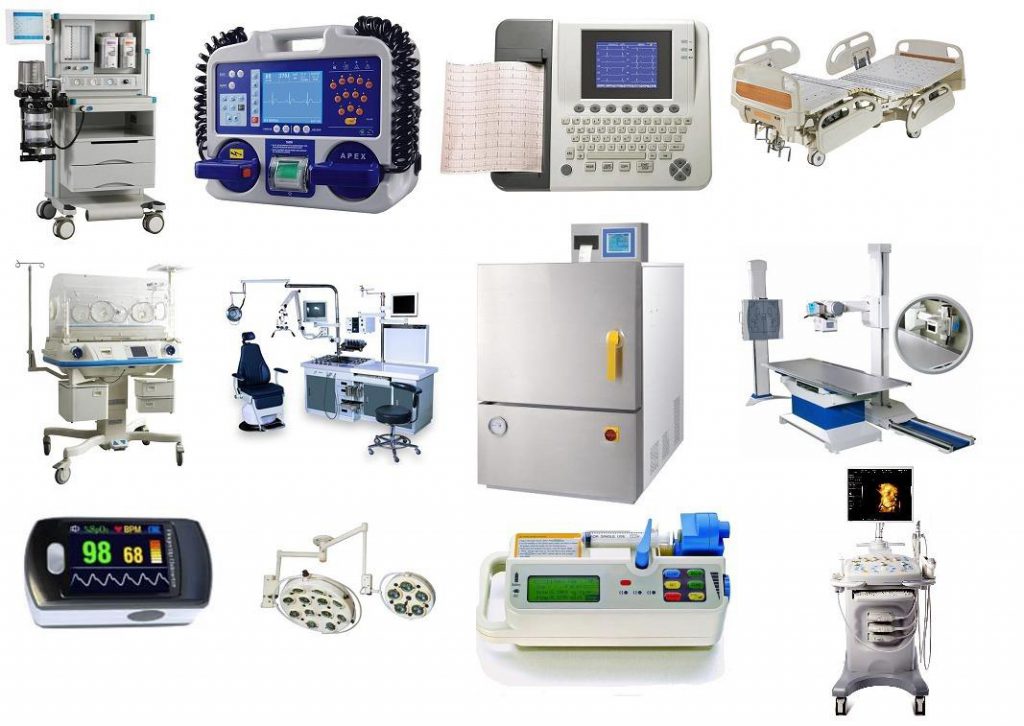
Chapter 5

Material Selection in Medical PCB
Material selection is a critical step in the manufacturing of medical PCB, as the materials used must ensure functionality, reliability, and safety. Given the stringent requirements of medical applications, materials need to provide excellent electrical performance, mechanical stability, and resistance to harsh sterilization processes. South-Electronic carefully selects materials for their medical PCB that meet these high standards, ensuring that each PCB delivers optimal performance in medical environments. Here’s an in-depth look at the considerations and choices involved in material selection for medical PCBs.
Substrate Materials
1. FR4:
- General Use: FR4 is the most commonly used material in PCB manufacturing, including in the medical sector, due to its good electrical insulating properties and adequate mechanical strength. It is cost-effective and suitable for a wide range of applications.
- Limitations: While FR4 is sufficient for many medical applications, it may not be suitable for high-frequency applications or environments where extreme temperatures are a factor.
2. Ceramic Substrates:
- Specialized Use: Ceramic substrates are used in medical PCB where high thermal conductivity and chemical stability are required. They are particularly common in high-power medical devices or those exposed to harsh chemical environments.
- Advantages: Ceramics can withstand very high temperatures and provide excellent electrical isolation, making them ideal for critical applications such as surgical devices and implants.
Conductive Materials
1. Copper:
- Standard Choice: Copper is the standard choice for conductive pathways in PCB due to its excellent electrical conductivity. In medical PCB, the thickness of the copper may vary depending on the current requirements of the device.
- Refinement: For medical applications, the purity and treatment of copper are often enhanced to improve its performance in terms of signal integrity and reliability.
2. Silver-Filled Conductive Inks:
- For Flexible PCB: In flexible medical PCB, such as those used in wearable devices, silver-filled conductive inks are often used. These inks are necessary for creating conductive paths on flexible substrates while maintaining the flexibility and durability required for medical applications.
Insulation and Solder Mask
1. Liquid Photo-Imaginable (LPI) Solder Mask:
- Common Use: LPI solder masks are widely used in medical PCB for their fine detail capabilities and durability. They provide high-resolution masking capabilities essential for densely packed medical devices.
- Properties: LPI solder masks are also known for their high chemical resistance and thermal stability, which are crucial in medical environments where devices may be exposed to sterilization processes.
2. High-Performance Laminates:
- Enhanced Protection: For additional protection, especially in devices that require high levels of sterilization or are exposed to bodily fluids, high-performance laminates can be used. These materials offer superior barrier properties, protecting the delicate internal components from environmental factors.
Considerations for Biocompatibility and Sterilization
- Biocompatibility: Materials used in medical PCB must be biocompatible, particularly for devices that come in direct contact with the human body. This consideration ensures that the materials do not cause any adverse reactions when used within or on the body.
- Sterilization Compatibility: The selected materials must withstand repeated sterilization cycles without degrading. This includes resistance to autoclaving, radiation, and chemical sterilants commonly used in medical settings.
South-Electronic takes these material considerations seriously, choosing only the highest quality materials suited for each specific medical application. By using materials that meet rigorous standards for electrical performance, mechanical stability, and environmental resistance, South-Electronic ensures that their medical PCB are reliable, safe, and effective in diverse medical applications, from portable diagnostic devices to complex surgical equipment.
Chapter 6
Manufacturing Process for Medical PCB
The manufacturing process for Medical PCB is intricate and highly regulated to ensure that each board meets the stringent requirements of the medical industry.
Medical PCB is essential components in devices that diagnose, treat, and monitor patients; thus, their production demands precision, cleanliness, and adherence to strict standards.
South-Electronic, known for its dedication to quality and innovation, exemplifies the best practices in medical PCB manufacturing. Below is a detailed description of the key stages involved in producing high-quality medical PCB.
Design and Pre-production
1. Design and Layout:
- CAD Software: Engineers at South-Electronic use advanced computer-aided design (CAD) software to create and layout PCB designs according to the specifications provided by the client or developed by their in-house design team. This stage involves careful consideration of circuit diagrams, component placement, and trace routing to ensure optimal performance and reliability.
- Design Review and DFM: Before proceeding to production, the design undergoes a thorough review process including a Design for Manufacturability (DFM) check, which ensures that the PCB can be manufactured reliably and cost-effectively while meeting all necessary medical standards.
2. Prototype Development:
- Rapid Prototyping: South-Electronic employs rapid prototyping techniques to quickly produce a working model of the PCB. This allows for functional testing and validation of the design before full-scale production begins, reducing the risk of costly reworks and ensuring that any design flaws are identified and corrected early in the process.
Production Process
3. Material Selection and Preparation:
- Substrate Materials: High-quality substrates such as FR4 or more advanced materials like polyimide are chosen based on their durability, thermal stability, and electrical properties. These materials are prepared and cut to size in a controlled environment to prevent contamination.
4. Photolithography and Etching:
- Layer Formation: Photolithographic processes are used to transfer the circuit image onto the substrate, which is then developed and etched to create the actual copper pathways. This requires precise control of exposure and development conditions to ensure accuracy and consistency.
5. Layer Stacking and Lamination:
- Multilayer Pressing: For multilayer PCB, individual layers are stacked and pressed together under high temperature and pressure to form a single, unified board. This step is critical for ensuring that the layers align perfectly and that the board has the necessary mechanical strength and electrical integrity.
6. Drilling and Plating:
- Hole Drilling: Holes for mounting components and vias for interconnecting layers are drilled using high-precision equipment.
- Through-hole Plating: The drilled holes are then plated with copper to establish reliable connections between the layers.
7. Component Assembly:
- Solder Paste Application: A stencil is used to apply solder paste to the areas where components will be placed.
- Pick and Place: Automated machines accurately place components onto the PCB.
- Reflow Soldering: The board passes through a reflow oven where the solder paste melts, solidifying the components to the board.
Testing and Quality Assurance
8. Inspection and Testing:
- Automated Optical Inspection (AOI): Immediately after assembly, PCB undergo AOI to check for soldering defects and component placement errors.
- Functional Testing: Each PCB is tested to ensure it performs according to its design specifications under simulated operating conditions.
9. Finishing and Packaging:
- Surface Finishing: Surface finishes such as ENIG (Electroless Nickel Immersion Gold) are applied to enhance solderability and protect against oxidation.
- Final Inspection: A final inspection is conducted to ensure that the PCB meet all quality and functionality standards.
- Packaging: PCB will be carefully packaged in anti-static materials and sealed to prevent damage during transportation.
Continuous Improvement and Compliance
South-Electronic’s manufacturing process is part of a continuous improvement cycle that incorporates feedback from both in-process testing and post-production performance.
Compliance with industry standards like ISO 13485 for medical devices is rigorously maintained, reflecting their commitment to producing medical PCB of the highest quality and reliability.
By adhering to these meticulous manufacturing steps and quality checks, South-Electronic ensures that its medical PCB can be relied upon in critical medical applications, ultimately contributing to safer and more effective patient care.

Chapter 7
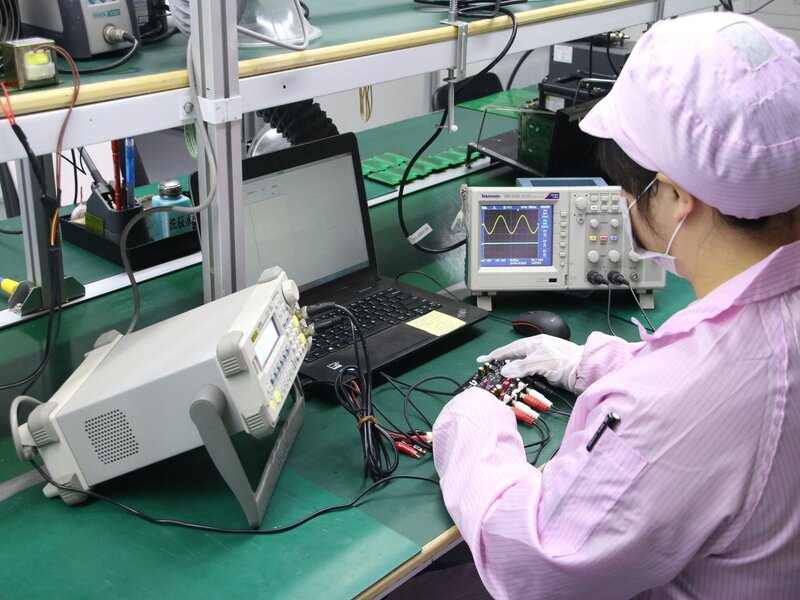
Testing and Quality Assurance for Medical PCBs
Testing and quality assurance are critical aspects of the medical PCB manufacturing process, ensuring that every PCB meets rigorous standards for reliability, performance, and safety. Given the vital role these components play in medical devices, failure is not an option. South-Electronic, as a leading provider of medical PCB, adheres to stringent testing protocols and quality assurance measures that exemplify industry best practices. This comprehensive approach guarantees the highest level of functionality and patient safety. Here’s a detailed look at the key steps and methodologies involved:
Comprehensive Testing Strategies
1. Electrical Testing:
- Continuity and Isolation Tests: These tests ensure that there are no shorts or opens in the circuit. South-Electronic utilizes advanced automated test equipment (ATE) to conduct these tests efficiently, ensuring that every connection and circuit path performs as intended.
- In-Circuit Testing (ICT): This method involves checking the mounted components on a PCB for operational functionality. It verifies that each component is correctly installed and functioning within specified parameters.
2. Functional Testing:
- Simulation of Real-world Conditions: South-Electronic conducts functional tests by simulating the operating conditions that the PCB will face in its actual medical application. This includes voltage and signal variations to ensure the PCB can reliably perform its intended functions under all potential conditions.
- Custom Test Rigs: For complex medical devices, custom test rigs are developed to perform end-to-end system tests, ensuring not just component functionality but also the interaction between different PCB and modules within the device.
3. Environmental and Stress Testing:
- Thermal Cycling and Temperature Testing: These tests expose the PCB to temperature extremes and cycles to ensure that it can withstand the operational environments of medical devices, which may vary greatly, especially in portable or outdoor applications.
- Vibration and Shock Testing: Given the potential physical stresses during use, especially in emergency medical services or mobile applications, PCB undergo vibration and shock testing to verify their structural integrity and durability.
Quality Assurance Protocols
1. Material Inspection:
- Incoming Quality Control (IQC): South-Electronic meticulously inspects all materials and components before they are used in the manufacturing process. This includes verifying supplier certifications and conducting material quality tests to ensure that everything meets the required medical standards.
2. Process Quality Control:
- Standard Operating Procedures (SOPs): Every step of the PCB manufacturing process is governed by detailed SOPs, which are crucial for maintaining high quality and consistency. These procedures are regularly updated based on the latest industry standards and technological advancements.
- Statistical Process Control (SPC): This technique is used to monitor and control the manufacturing process through statistical analysis, ensuring that it operates at its highest efficiency and is capable of producing outputs that meet the required quality standards.
3. Final Inspection and Quality Checks:
- Automated Optical Inspection (AOI): After assembly, PCB undergo an AOI process where high-resolution cameras inspect the solder connections and alignment of components to ensure there are no defects.
- X-ray Inspection: This is particularly important for checking solder quality under components like BGAs (Ball Grid Arrays), where connections are not visible externally. X-rays allow for a non-destructive examination of these hidden features.
Continuous Improvement and Compliance
South-Electronic is committed to continuous improvement in its quality assurance practices, incorporating feedback from testing phases back into the design and manufacturing processes. Compliance with international standards such as ISO 13485 for medical devices is a cornerstone of their QA program, ensuring that their PCB not only meet but often exceed the requirements of medical device manufacturers.
By implementing these comprehensive testing and quality assurance measures, South-Electronic ensures that each PCB they produce is capable of performing its critical functions reliably and safely in any medical setting. This commitment to quality not only enhances the reliability of medical devices but also supports the overall mission of improving patient care and outcomes.
Chapter 8
Applications of Medical PCB in Healthcare
PCB is crucial components in a vast array of medical devices. South-Electronic is crafting PCB that enhance device performance and patient care. Below, we explore several key areas where medical PCB play pivotal roles:
Diagnostic Equipment
Medical PCB is integral to the function of diagnostic equipment, from blood glucose monitors to complex imaging systems like MRI and CT scanners. These devices rely on PCB for processing data, controlling mechanisms, and interfacing with detection technologies. South-Electronic designs PCB that meet the precise needs of these systems, ensuring high reliability for critical tasks such as capturing and analyzing patient data. For example, in MRI machines, PCB must manage massive data throughput and high power loads while operating reliably in the presence of strong magnetic fields.
Patient Monitoring Systems
In critical and emergency care, continuous monitoring of patient vitals such as heart rate, oxygen saturation, and blood pressure is essential. Medical PCB in these devices must perform flawlessly to ensure real-time tracking and alerting. Wearable technology, another growing sector, utilizes flexible PCB for continuous health monitoring, allowing for patient mobility without compromising medical oversight. South-Electronic contributes to this field by providing durable and precise PCB that power devices used in hospitals and home settings, enhancing patient care and supporting remote monitoring initiatives.
Therapeutic Devices
Therapeutic medical devices like dialysis machines, infusion pumps, and electrical stimulation devices all rely on medical PCB for operational control and precision. These devices often require custom PCB solutions that can handle specific power requirements and safety features essential for patient treatment. South-Electronic’s expertise in high-power and safety-critical PCB designs ensures that these therapeutic devices operate efficiently and safely, minimizing risks and improving treatment outcomes.
Surgical and Medical Robotics
As surgical techniques advance, robotics has become an integral part of the operating room. Medical robotics relies heavily on PCB for motor control, sensor integration, and real-time processing. These PCB must be highly reliable and compact, fitting into the tight confines of robotic systems while ensuring precise operation during surgeries. South-Electronic manufactures robust and precise PCB that are essential for the fine control and feedback mechanisms in surgical robots, thus facilitating minimally invasive procedures with better precision and lower recovery times.
Wearable Medical Technology
The field of wearable health technology is expanding rapidly, with devices that monitor health metrics and provide medical alerts. These wearables require flexible or rigid-flex PCB that are lightweight, durable, and capable of continuous operation under various conditions. South-Electronic specializes in flexible PCB solutions that integrate seamlessly into wearable devices, supporting innovations in patient care and health management.
Laboratory Equipment
Medical PCB is also crucial in laboratory environments, powering devices that perform genetic analysis, blood testing, and pathogen detection. These applications require PCB with capabilities to handle delicate and precise measurements and controls. South-Electronic provides PCB that ensure reliability and accuracy in lab equipment, aiding in faster and more accurate diagnostic capabilities.

Chapter 9
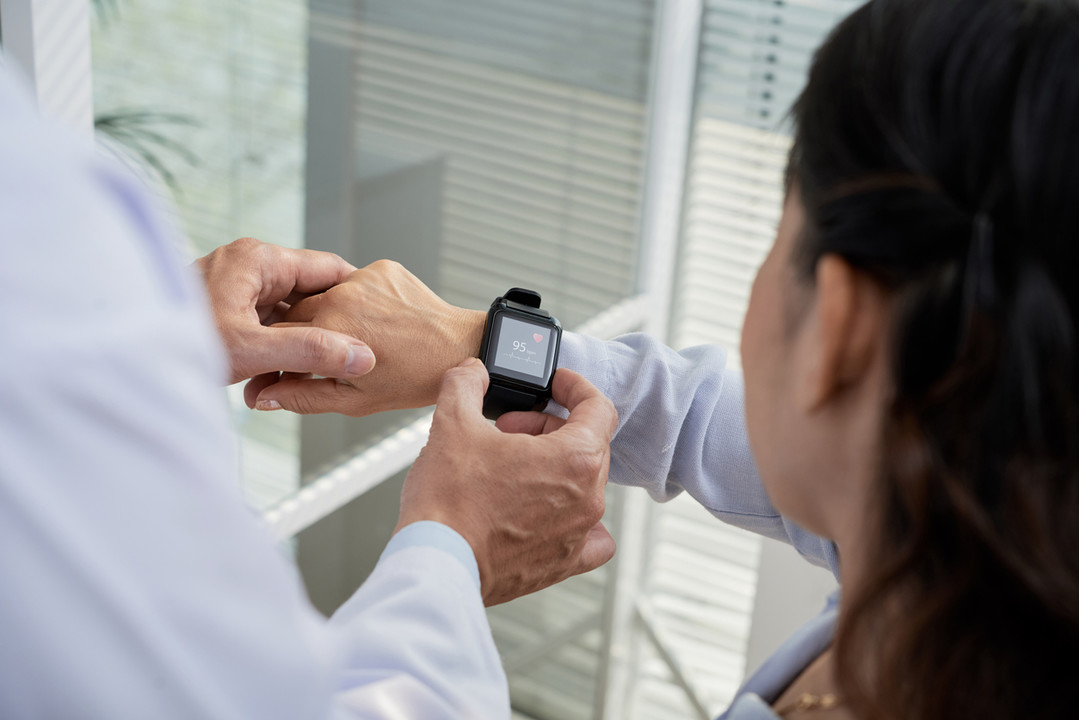
Innovations and Future Trends in Medical PCB
As we delve into the innovations and future trends in medical PCB, it’s evident that factors like miniaturization, improved materials, and smarter technology are leading the charge. South-Electronic, as a leader in the industry, is at the forefront of integrating these innovations to deliver advanced medical device capabilities.
Miniaturization
One of the most critical trends in the development of medical PCB is miniaturization. The drive towards making devices smaller, more efficient, and capable of performing more complex functions within a compact space is paramount. Miniaturization allows for the development of highly portable medical devices, which are particularly beneficial in patient monitoring, diagnostics, and wearable health technology. South-Electronic leverages sophisticated HDI (High Density Interconnect) technology to manufacture smaller PCB with higher functionality, which are essential for modern medical devices like wearable heart monitors and smart implants.
Advanced Materials
The materials used in PCB manufacturing are evolving to enhance performance and compatibility with the human body. New substrate materials that offer improved high-temperature performance and better mechanical stability are becoming more common. These materials include ceramics and advanced polymers that are biocompatible and capable of withstanding the rigorous sterilization processes often required in medical settings. South-Electronic is exploring the use of these innovative materials to create PCB that are not only more effective but also safer and more reliable.
Flexible and Rigid-Flex PCB
The development and increased use of flexible and rigid-flex PCB are reshaping medical device design. The PCB offer the unique advantage of conforming to unusual shapes, which is particularly useful in medical applications like implants or compact medical wearables. South-Electronic utilizes state-of-the-art flexible PCB technology to provide solutions that can integrate seamlessly into highly customized medical devices, enhancing both their function and patient comfort.
Integration of Smart Technologies
As the Internet of Things (IoT) expands into the medical field, PCB is being designed to facilitate smarter healthcare solutions. This includes integration with wireless technology for real-time health monitoring and data collection. South-Electronic is integrating IoT capabilities into their medical PCB, enabling devices to communicate with healthcare providers’ systems, ensuring timely updates on patient conditions and facilitating remote diagnostics and treatment options.
3D Printing of PCB
3D printing technology is starting to play a role in PCB manufacturing, offering the ability to produce more complex geometries and multi-layer circuits more efficiently. This technology also allows for rapid prototyping, speeding up the development process and enabling more customization. South-Electronic is adopting 3D printing techniques to enhance their prototyping capabilities, which allows for faster iteration and innovation in PCB design.
Environmental Sustainability
The trend towards environmental sustainability is also influencing the medical PCB industry. Manufacturers like South-Electronic are increasingly focusing on reducing waste and using materials and processes that are environmentally friendly. This includes recycling old PCBs and using non-toxic materials in the manufacturing process, which not only helps the environment but also improves the safety of the PCBs in medical applications.
Future Outlook
Looking to the future, we can expect the medical PCB industry to continue evolving with the integration of artificial intelligence (AI) for predictive diagnostics and the use of nanotechnology for even greater miniaturization and functionality. South-Electronic is poised to incorporate these advanced technologies, ensuring that their medical PCBs remain at the cutting edge of medical device innovation.
These innovations and trends highlight the dynamic nature of the medical PCB industry and South-Electronic’s commitment to advancing medical technology. As these technologies develop, they promise to bring even more sophisticated solutions to healthcare, ultimately improving patient outcomes and the effectiveness of medical treatments.
Chapter 10
Choosing a Medical PCB Provider
When selecting a Medical PCB provider, the decision can significantly influence the quality, compliance, and reliability of your medical devices. South-Electronic, with its robust experience and specialized services, stands out as a prime candidate in this field. Here’s a detailed guide on what to consider when choosing a provider, with South-Electronic exemplifying these qualities:
Expertise and Experience
The expertise of your PCB provider is crucial, particularly in the medical field where precision and reliability are paramount. South-Electronic has extensive experience in manufacturing high-quality Medical PCB, backed by years of service in the industry.
- Proven Track Record: South-Electronic offers a portfolio filled with successful projects and client testimonials that highlight their capacity to deliver top-tier medical PCB.
- Specialized Medical Division: With a dedicated division for medical products, South-Electronic ensures focused expertise and tailored solutions for medical applications.
Certifications
Certifications are non-negotiable in medical PCB manufacturing, signifying a provider’s commitment to quality and safety standards.
- ISO 13485 Certified: South-Electronic is ISO 13485 certified, showcasing their commitment to consistent quality management in medical device manufacturing.
- Other Certifications: Beyond ISO 13485, South-Electronic maintains multiple certifications that validate their processes and products, ensuring adherence to international standards.
Quality Assurance and Reliability
The reliability of your medical PCB is a direct outcome of rigorous quality assurance processes.
- Comprehensive Testing Protocols: South-Electronic employs advanced testing protocols at every production stage to ensure each PCB meets the highest standards of quality and reliability.
- Material Sourcing: They use premium materials sourced from trusted suppliers, which is crucial for producing durable and effective medical PCB.
Technological Capabilities
Advanced technological capabilities allow a PCB provider to offer cutting-edge solutions that enhance the functionality and integration of medical devices.
- State-of-the-Art Manufacturing: South-Electronic utilizes the latest manufacturing technologies, including HDI capabilities and advanced etching processes, to deliver superior medical PCB.
- Design Support Services: They provide expert design support, helping clients optimize their PCB designs for better performance and manufacturability.
Customer Service and Support
Effective communication and comprehensive support are vital for navigating the complexities of medical PCB production.
- Responsive Communication: South-Electronic is known for its proactive customer service, ensuring clear and continuous communication throughout the project lifecycle.
- After-Sales Support: They offer extensive after-sales support, including troubleshooting and consultations, to ensure seamless integration and functionality of their PCB in medical devices.
Flexibility and Scalability
Your provider should be able to adjust to your project’s scale and complexity without compromising on quality.
- Scalable Production Capabilities: Whether you need small-scale prototypes or large-volume production runs, South-Electronic can accommodate your needs with efficiency and precision.
- Customization Expertise: Tailoring solutions to meet specific medical applications is a strength of South-Electronic, reflecting their commitment to customer-specific needs.
Cost Considerations
While quality should never be compromised for cost, competitive pricing and clear value propositions are important.
- Competitive Pricing: South-Electronic offers transparent and competitive pricing models that ensure good value for the quality and services provided.
- Total Cost of Ownership: They focus on reducing the total cost of ownership for their clients by ensuring high reliability and minimizing potential downtime or failures.
Selecting the right medical PCB provider is crucial for ensuring the success of your medical devices.
South-Electronic exemplifies the qualities to look for in a provider, from advanced manufacturing capabilities and rigorous quality controls to excellent customer service and flexible production options.
By choosing a provider like South-Electronic, you can ensure a partnership that enhances the quality and reliability of your medical devices while adhering to the strict standards required in the medical field.


